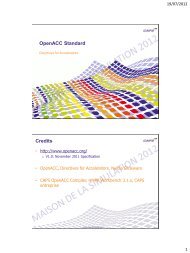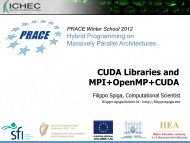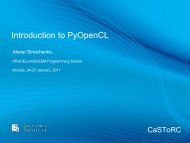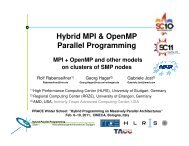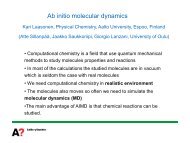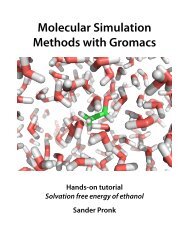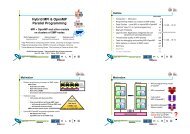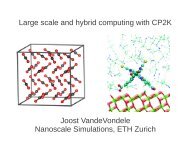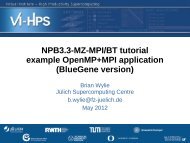JUQUEEN: Blue Gene/Q - System Architecture - Prace Training Portal
JUQUEEN: Blue Gene/Q - System Architecture - Prace Training Portal
JUQUEEN: Blue Gene/Q - System Architecture - Prace Training Portal
You also want an ePaper? Increase the reach of your titles
YUMPU automatically turns print PDFs into web optimized ePapers that Google loves.
Mitglied der Helmholtz-Gemeinschaft<strong>JUQUEEN</strong>:<strong>Blue</strong> <strong>Gene</strong>/Q - <strong>System</strong><strong>Architecture</strong>M. Stephan
Outline§ <strong>Blue</strong> <strong>Gene</strong>/Q hardware design§ Processor§ Network§ I/O architecture§ Jülich <strong>Blue</strong> <strong>Gene</strong>/Q configuration (<strong>JUQUEEN</strong>)§ <strong>Blue</strong> <strong>Gene</strong>/Q software overview§ Programming model§ <strong>Blue</strong> <strong>Gene</strong>/Q software stack05.07.2012 2
Mitglied der Helmholtz-Gemeinschaft<strong>Blue</strong> <strong>Gene</strong>/Q– Hardware
<strong>Blue</strong> <strong>Gene</strong> design goals§ <strong>System</strong>-on-Chip (SoC) design§ Processor comprises both processing cores and network§ Optimal performance / watt ratio§ Small foot print§ Transparent high-speed reliable network§ Easy programming based on standard message passinginterface (MPI)§ Extreme scalability ( > 1,5Mi cores)§ High reliability05.07.2012 4
<strong>Blue</strong> <strong>Gene</strong> evolution<strong>Blue</strong> <strong>Gene</strong>/L (5.7 TF/rack) – 130nm ASIC (Dev.:1999-2004)§ PPC440 core, dual core SoC, 0.5/1 GB/node§ Biggest installed system (LLNL):§ 104 racks, 212,992 cores/threads, 596 TF/s, 210 MF/W<strong>Blue</strong> <strong>Gene</strong>/P (13.9 TF/rack) – 90nm ASIC (Dev.:2004-2007)§ PPC450 core, quad core SeC, DMA, 2/4 GB/node§ Biggest installed system (Jülich):§ 72 racks, 294,912 cores/threads, 1 PF/s, 357 MF/W05.07.2012 5
<strong>Blue</strong> <strong>Gene</strong> evolutionBG/Q (209 TF/rack) – 45nm ASIC+ (Dev.: 2007-2012)§ A2 core, 16 core/64 thread SoC§ 16 GB/node§ Biggest installed system (LLNL):§ 96 racks, 1,572,864 cores & >6M threads,20 PF/s, 2 GF/W§ Speculative execution, sophisticated L1 prefetch,transactional memory, fast thread handoff, compute +IO systems.05.07.2012 6
<strong>Blue</strong> <strong>Gene</strong>/P designNode Card(32 chips 4x4x2)32 compute, 0-2 IO cards435 GF/s, 64 GB Rack32 Node CardsCabled 8x8x1613.9 TF/s, 2 TB<strong>System</strong>72 Racks, 72x32x321 PF/s, 144 TBChip4 processors13.6 GF/s Compute Card1 chip, 13.6 GF/s2.0 GB DDR2(4.0GB optional)Source: IBM05.07.2012 7
<strong>Blue</strong> <strong>Gene</strong>/P compute card<strong>Blue</strong> <strong>Gene</strong>/P compute ASIC4 cores, 8MB cacheCu heatsinkSDRAM – DDR22GB memoryNode card connectornetwork, power05.07.2012 8
<strong>Blue</strong> <strong>Gene</strong>/P node card05.07.2012 9
<strong>Blue</strong> <strong>Gene</strong>/Q design3. Compute Card (“Node”):One BQC Module (1x1x1x1x1),16 GB DDR3 Memory4. Node Card (“Node Board”):32 Compute Cards (2x2x2x2x2),Optical Modules, BQL Link Chips, Torus5b. I/O drawer (1,2 or 4 per rack):* 8 I/O cards @ 16 GB,* 8 PCIe gen2 x8 slots (IB, 10GbE)6. Rack: 2 Midplanes (4x4x4x8x2)1,2 or 4 I/O Drawer7. <strong>System</strong>:e.g. 8 racks (8x8x8x8x2) = 1.7 PF/se.g. 28 racks (8x28x8x8x2) = 5.9 PF/se.g. 96 racks (16x12x16x16x2) = 20 PF/s5a. Midplane:16 Node Cards (4x4x4x4x2)Source: IBM05.07.2012 10
<strong>Blue</strong> <strong>Gene</strong>/Q compute cardSource: Top500.org05.07.2012 12
<strong>Blue</strong> <strong>Gene</strong>/Q: Chip tomographySource: IBM05.07.2012 13
<strong>Blue</strong> <strong>Gene</strong>/Q: A2 processor coreBQC processor core (A2 core)• Simple core, designed for excellent§ power Simple efficiency core and small footprint.• Embedded § designed 64 bit for PowerPC excellent compliant powerefficiency and small footprint• 4 SMT threads typically get a high§ level Embedded of utilization 64bit on PowerPC shared compliant§ resources. 4 SMT threads typically get a high level• Design of utilization point is on 1.6 shared GHz @ resources 0.74V.§ Full register set for every thread• AXU port allows for unique BGQ style§ floating 1.6 GHz point @ 0.74V§ AXU port allows unique BG/Q floating• One AXU (FPU) and one otherpoint unitinstruction issue per cycle§ One AXU (FPU) and one other• In-order instruction execution issue per cycle§ In-order executionPrvUcodeCtrlROMMMUTLBDep/IssueFixedPointThreadFetchSequenceriERATGPRBranchI$IBufferdERATLoad/StoreD$BranchPredictionAXUDep/IssueAXUIUXUAXUL2 InterfaceSource: IBM05.07.2012 15© 2009 IBM Corporation
<strong>Blue</strong> <strong>Gene</strong>/Q: Multithreading§ Four threads issuing to two pipelines§ Impact of memory access latency reduced§ Issue§ Flush§ Up to two instructions issued per cycle§ One Integer/Load/Store/Control instruction issue per cycle§ One FPU instruction issue per cycle§ At most one instruction issued per thread§ Pipeline is not stalled on conflict§ Instead,§ Instructions of conflicting thread are invalidated§ Thread is restarted at conflicting instruction§ Guarantees progress of other threads05.07.2012 16
Quad floating Point eXtension unit (QPX)§§§§§§§4 double precision pipelines (64bit):§ scalar FPU§ 4-wide FPU SIMD§ 2-wide complex arithmeticSIMD32 x 4 x 256 bit registersInstruction extensions to PowerISA8 concurrent floating point ops(FMA) + load + storePermute instructions to reorganizevector dataSupports a multitude of dataalignmentsPeak performance 4FMA / cycle§ 12.8 GFlops @ 1.6 GHz05.07.2012 17
Memory hierarchy05.07.2012 18
<strong>Blue</strong> <strong>Gene</strong>/Q: Advanced processor featuresL1 pre-fetching engines§ Stream pre-fetching§ 1 engine per core§ “Perfect” (list) pre-fetching§ 4 engines per core§ Hardware memorizes access sequenceMulti-versioning L2 cache§ Cache can track state changes caused by speculative threads§ At the end of speculative code: invalidate or commit and/or reactwith software notification§ Use: transactional memory, thread-level speculation05.07.2012 19
<strong>Blue</strong> <strong>Gene</strong>/Q: Thread Level Speculation§§§§§§Parallelize potentially dependent serial fragments§ runtime creates threads for each speculative section§ threads run parallel and commit serialized if no conflict§ on conflict, all threads except current master is rolled backEnable by compiler flag -qsmp=speculativePerformance governed by trade off of overhead and conflict probabilityTimes to try rollback before non-sepc. execution:§ export SE_MAX_NUM_ROLLBACK=NHardware Limitation: maximum of 16 domainsTurn on logs to inspect runtime-gathered statistics for tuning: (see IBM XLOptimization Guide)§ export SE_REPORT_...=...05.07.2012 20
Thilo Maurer, IBM R&D Böblingen<strong>Blue</strong> <strong>Gene</strong>/Q: Transactional MemoryTransactional Memory➢§BG/Q has support for hardwareBG/Q transactional has support memory for hardwaretransactional memory●mechanism to enable atomic§ mechanism operations on to enable arbitrary atomic set ofoperations memory locations on arbitrary set ofmemory locations●App needs to allow that§ App needs to allow thattransactions commit out-ofordertransactions commit out-oforder●may be used to parallelize§ may be used to parallelizeworkload into collaborative butworkload into collaborative butindepenent tasks on sharedindepenent tasks on shareddatadata●§ hardware detects write/readconflicts●§ runtime rolls back on on failureSingle MPITaskUser defined parallelismHardwaredetecteddependencyconflictrollbackparallelizationcompletionsynchronization pointUser definedtransaction startUser definedtransactionend05.07.2012 © 2012 IBM Corporation 21
Comparison with other processors05.07.2012 22
<strong>Blue</strong> <strong>Gene</strong>/Q ↔ <strong>Blue</strong> <strong>Gene</strong>/PProperty <strong>Blue</strong> <strong>Gene</strong>/Q <strong>Blue</strong> <strong>Gene</strong>/PNodePropertiesNode ProcessorsProcessor FrequencyCoherencyCache size (shared)Main StoreMain Store Bandwidth (1:2 pclk)Peak Performance16*4 PowerPC® A21.6GHzSMP32MB16GB42.6GB/s204.8GF/node4* 450 PowerPC®0.85GHzSMP8MB2GB13.6 GB/s13.9 GF/nodeTorusNetworkTopologyBandwidthHardware Latency (NearestNeighbour)Hardware Latency (Worst Case)5D10*2*2GB/s=40GB/s40ns (32B packet)300?ns (512B packet)2.6µs (31 hops)3D6*2*425MB/s=5.1GB/s100ns (32B packet)800ns (256B packet)3.2µs(64 hops)TreeNetworkBandwidthHardware Latency (worst case)6.5µs2*0.85GB/s=1.7GB/s3.5µs<strong>System</strong>PropertiesAreaPeak PerformanceTotal Power~20m 21.7PF~400kW160m 21.008PF~2.3MW05.07.2012 23
Execution Modes in BG/Q64 MPI tasks1 Thread / Task2,4,8,16,32 MPI tasks32,16,8,4,2 Threads1 MPI task1-64 Threads / TaskP0P1P0PyP0T0T0T0T0T0T1PxP63T0T0TxTxTxT6305.07.2012 24
<strong>Blue</strong> <strong>Gene</strong>/Q: <strong>System</strong> configurations05.07.2012 27
Torus node to MPI mapping§§§Block's physical network topology: 6 dimensional A×B×C×D×E×T§ local on each node; shared memory communication (fast); T=0..63§ A,B,C,D,E depend on size of block, e.g. 2×2×4×4×2 for quartermidplaneprocesses need to be placed to minimize maximum load on network-links§ take advantage of logical decomposition of work§ take advantage of link in E direction: double bandwidth available§ e.g. domain decomposition: find best match of physical and logicaldimensionsThree options to define mapping:§ By permutation of physical dimensions (--mapping DCTEBA)§ Use MPI_Cart_Create() (to date: only reordering of dimensions)§ By a file with a line for each process, specifying its physical position (--mapping )05.07.2012 28
Linktest: <strong>Blue</strong> <strong>Gene</strong> torus link bandwidth tester§ All-to-all ping-pong test§ Bandwidth distribution§ Intra-node communication§ Communication via link A, B, C, D§ Communication via link E05.07.2012 29
BG/Q External I/O<strong>Blue</strong> <strong>Gene</strong>/Q: I/O architecture• I/O Network to/from Compute rack– 2 links (4GB/s in 4GB/s out) feed an I/O PCI-e port– Every node card has up to 4 ports (8 links)– Typical configurations• 8 ports (32GB/s/rack)• 16 ports (64 GB/s/rack)• 32 ports (128 GB/s/rack)– Extreme configuration 128 ports (512 GB/s/rack)I/O drawers• I/O Drawers– 8 I/O nodes/drawer with 8 ports (16 links) to compute rack– 8 PCI-e gen2 x8 slots (32 GB/s aggregate)– 4 I/O drawers per compute rack– Optional installation of I/O drawers in external racks for extremebandwidth configurationsPCIeI/O nodes© 2009 IBM Corporation05.07.2012 30
<strong>JUQUEEN</strong> Configuration (04/2012)8 Racks <strong>Blue</strong> <strong>Gene</strong>/Q§ 8192 Compute Nodes (16 cores, 16 GB memory)§ 131072 cores / 0.5M treads§ 1.68 PFlop/s peak performance§ 88 I/O nodes (10GigE) ← (1x32 + 7x8)§ 400 kW power consumption (10-50 kW per rack)2 Frontend Nodes (user login) + 2 Service Nodes (system, database)§ IBM p7 740, 8 cores (3.55 GHz), 128 GB memory§ local storage device DS5020 (16 TB)05.07.2012 31
<strong>JUQUEEN</strong> Configuration (11/2012)28 Racks <strong>Blue</strong> <strong>Gene</strong>/Q§ 28672 Compute Nodes (16 cores, 16 GB memory)§ 458752 cores / 1.8M threads§ 5.88 PFlop/s peak performance§ 248 I/O nodes (10GigE) ← (1x32 + 27x8)§ 1.4 MW power consumption (10-50 kW per rack)4 Frontend Nodes (user login) + 2 Service Nodes (system, database)§ IBM p7 740, 8 cores (3.55 GHz), 128 GB memory§ local storage device DS5020 (16 TB)05.07.2012 32
JuQueen EnvironmentBG/QControl-<strong>System</strong>Service NodeService NoderunjobFrontEndFrontEndSSHRAIDDB2Fileserver JUST05.07.2012 33
<strong>JUQUEEN</strong>: First pictures05.07.2012 34
<strong>JUQUEEN</strong>: First pictures05.07.2012 35
<strong>JUQUEEN</strong>: First pictures05.07.2012 36
<strong>JUQUEEN</strong>: First pictures05.07.2012 37
<strong>JUQUEEN</strong>: First pictures05.07.2012 38
<strong>JUQUEEN</strong>: First pictures05.07.2012 39
Mitglied der Helmholtz-Gemeinschaft<strong>Blue</strong> <strong>Gene</strong>/Q– Software
<strong>Blue</strong> <strong>Gene</strong>/Q: MPI Implementation• MPI-2.1 standard (http://www.mpi-forum.org/docs/docs.html)• To support the <strong>Blue</strong> <strong>Gene</strong>/Q hardware, the following additions andmodifications have been made to the MPICH2 softwarearchitecture:• A <strong>Blue</strong> <strong>Gene</strong>/Q driver has been added that implements theMPICH2 abstract device interface (ADI).• Optimized versions of the Cartesian functions exist(MPI_Dims_create(), MPI_Cart_create(), MPI_Cart_map()).• MPIX functions create hardware-specific MPI extensions.05.07.2012 41
<strong>Blue</strong> <strong>Gene</strong>/Q: Parallel Active Message InterfaceParallel Active Message InterfaceApplicationHigh-LevelAPIConverse/Charm++MPICHGlobalArraysARMCIUPC*OtherParadigms*Low-LevelAPIPAMI API (C)pt2pt protocolscollective protocolsDMA Device Collective Device GI Device Shmem DeviceMessage Layer Core (C++)SPINetwork Hardware (DMA, Collective Network, Global Interrupt Network)• Message Layer Core has C++ message classes and other utilities to program the different network devices• Support many programming paradigms05.07.2012 42
<strong>Blue</strong> <strong>Gene</strong>/Q: Extra MPI communicators• int MPIX_Cart_comm_create (MPI_Comm *cart_comm)• This function creates a six-dimensional (6D) Cartesiancommunicator that mimics the exact hardware on which it isrun. The A, B, C, D, and E dimensions match those of the blockhardware, while the T dimension is equivalent to the ranks pernode argument to runjob.• Changing class-route usage at runtime• int MPIX_Comm_update(MPI_Comm comm, int optimize)• Determining hardware properties• int MPIX_Init_hw(MPIX_Hardware_t *hw);• int MPIX_Torus_ndims(int *numdimensions)• int MPIX_Rank2torus(int rank, int *coords)• int MPIX_Torus2rank(int *coords, int *rank)05.07.2012 43
<strong>Blue</strong> <strong>Gene</strong>/Q: Compute Node Kernel (CNK)§ Binary Compatible with Linux <strong>System</strong> Calls§ Leverage Linux runtime environments and tools§ Up to 64 Processes (MPI Tasks) per NodeCNK Overview§ SPMD and MPMD Support§ Multi-Threading:§ optimizedComputeruntimesNodeNativeKernelPOSIX(CNK)Threading LibraryBinary Compatible with Linux <strong>System</strong> Calls(NPTL)Leverage Linux runtime environments and tools§ OpenMP via Up XL to 64 and Processes Gnu Compilers (MPI Tasks) per NodeSPMD and MPMD Support§ Thread-Level Multi-Threading: Speculation optimized (TLS) runtimesNative POSIX Threading Library (NPTL)§ <strong>System</strong> Programming OpenMP Interfaces via XL and Gnu Compilers (SPI)Thread-Level Speculation (TLS)§ Networks and DMA<strong>System</strong> Programming Interfaces (SPI)§ Global Interrupts Networks Synchronizationand DMA, Global InterruptsSynchronization, Locking, Sleep/Wake§ Locking, Sleep/WakePerformance Counters (UPC)§ Performance MPI Counters and OpenMP (UPC) (XL, Gnu)Transactional Memory (TM)§ MPI and OpenMP (XL-, Gnu-Compiler)Speculative Multi-Threading (TLS)§ Transactional Memory Shared and (TM) Persistent MemoryScripting Environments (Python)§ Speculative Multi-Threading (TLS)Dynamic Linking, Demand Loading§ Shared and Persistent Memory§ Scripting Environments Firmware (Python)§ Dynamic Linking, Demand LoadingBoot, Configuration, Kernel LoadControl <strong>System</strong> InterfaceCommon RAS Event Handling for CNK &05.07.2012 Linux44
<strong>Blue</strong> <strong>Gene</strong>/Q: ProcessesProcesses§• Similarities to BGP– § Number of tasks of tasks per per node node fixed fixed at job at start job start– § No No fork/exec support support– § Support static static and and dynamically dynamically linked linked processes processes• Plus: § -np supported§ Plus: – 64-bit processes– § Support 64-bit for processes 1, 2, 4, 8, 16, 32, or 64 processes per node§ • Support Numeric for “names” 1, 2, 4, for 8, process 16, 32, config. or 64 processes (i.e., not smp, per dual, node quad, octo,vnm, § Numeric etc) “names” for process config. (i.e., not smp, dual, …, vnm)– § Processes use use 16 cores 16 cores– § The The 17th 17th core core on BQC on BQC reserved reserved for: for:• Application agents§ Application agents• Kernel networking§ Kernel networking• RAS offloading§ RAS offloading– Sub-block jobs§ Sub-block jobs§• Minus– § No No support support for for 32-bit 32-bit processes processes05.07.2012 © 2009 IBM Corporation 45
<strong>Blue</strong> <strong>Gene</strong>/Q: ThreadsThreads• Similarities to BGP– POSIX NPTL threading support• E.g., libpthread• Plus– Thread affinity and thread migration– Thread priorities• Support both pthread priority and A2 hardware thread priority– Full scheduling support for A2 hardware threads– Multiple software threads per hardware thread is now the default– CommThreads have extended priority range compared to normal threads– Performance features• HWThreads in scheduler without pending work are put into hardwarewait stateNo cycles consumed from other hwthreads on core• Snoop scheduler providing user-state fast access to:Number of software threads that exist on the current hardware threadNumber of runnable software threads on the current hardware thread05.07.2012 46© 2009 IBM Corporation
<strong>Blue</strong> <strong>Gene</strong>/Q: MemoryMemory• Similarities to BGP– Application text segment is shared– Shared memory– Memory Protection and guard pages• Plus– 64-bit virtual addresses• Supports up to 64GB of physical memory*• No TLB misses• Up to 4 processes per core– Fixed 16MB memory footprint for CNK. Remainder of physical memory toapplications– Memory protection for primordial dynamically-linked text segment– Memory aliases for long-running TM/SE– Globally readable memory– L2 atomics05.07.2012 47© 2009 IBM Corporation
<strong>System</strong> Calls<strong>Blue</strong> <strong>Gene</strong>/Q: <strong>System</strong> Calls§ Similarities to to BGP BG/P– Many § Many common common syscalls syscalls on Linux on Linux work work on BG/Q. on BG/Q.– Linux § Linux syscalls syscalls that that worked worked on BGP on BG/P should should work work on BGQ on BGQ§ Plus Plus § Support glibc 2.12.2– Support § Real-time glibc signals 2.12.2 support– Real-time § Low overhead signals support syscalls– Low overhead § Only essential syscallsregisters are saved and restored§• Pluggable Only essential File <strong>System</strong>s registers are saved and restored– Pluggable § Allows File <strong>System</strong>s CNK to support multiple file system behaviors and• Allows types CNK to support multiple file system behaviors and types§ Different simulator platforms have have different capabilities• File § Shared systems:Si MemoryFunction shippedStandard I/ORamdiskShared Memory05.07.2012 48
<strong>Blue</strong> <strong>Gene</strong>/Q: I/O ServicesI/O Services• Similarities to BGP– Function shipping system calls to ionode– Support NFS, GPFS, Lustre and PVFS2 filesystems• Plus– PowerPC64 Linux running on 17 cores– Supports 8192:1 compute task to ionode ratio• Only 1 ioproxy per compute node• Significant internal changes from BGP– Standard communications protocol• OFED verbs• Using Torus DMA hardware for performance– Network over Torus• E.g., tools can now communicate betweenIONodes via torus– Using “off-the-shelf” Infiniband driver from Mellanox– ELF images now pulled from I/O nodes, vs push05.07.2012 49© 2009 IBM Corporation
© 2009 IBM CorporationDebugging<strong>Blue</strong> <strong>Gene</strong>/Q: Debugging• Similarities to BGP– GDB– Totalview– Coreprocessor– Dump_all, dump_memory– Lightweight and binary corefiles• Plus– Tools interface (CDTI)• Allows customers to write custom debug and monitoring tools– Support for versioned memory (TM/SE)– Fast breakpoint and watchpoint support– Asynchronous thread control• Allow selected threads to run while others are being debugged05.07.2012 50
Compiling MPI programs on <strong>Blue</strong> <strong>Gene</strong>/QThere are six versions of the libraries and the scripts§ gcc: GNU compiler with fine-grained locking in MPICH –error checking§ gcc.legacy: GNU with coarse-grained lock – sligthy betterlatency for single-thread code§ xl: PAMI compiled with GNU – fine-grained lock§ xl.legacy: PAMI compiled with GNU – coarse-grained lock§ xl.ndebug: xl with error checking and asserts off ⇒lowerlatency but not as much debug info§ xl.legacy.ndebug: xl.legacy with error checking and assertsoff05.07.2012 51
Mitglied der Helmholtz-GemeinschaftStorage
Filesystems§ The user can store his datasets in three different filesystems§ $HOME§ $WORK§ $ARCH05.07.2012 53
Filesystems – $HOME§ Daily backup§ For regular used datasets and applications§ 3 TB space and 2 million datasets per group§ Quota information with q_dataquota§ Urgent datasets which are used for the currentcomputation05.07.2012 54
Filesystems – $WORK§ Fastest file system (33 GB/s)§ No backup§ Datasets will be deleted 90 days after the last usage§ Quota of 6 TB and 4 million datasets per group§ For datasets which are used or generated during thecomputation§ Urgent datasets should be copied to $ARCH or $HOME05.07.2012 55
Filesystems – $ARCH§ Daily backup§ All datasets will be migrated to tape§ Large, not recently used datasets§ No space quota, 2 million datasets per group§ NOT available on the <strong>Blue</strong> <strong>Gene</strong> compute nodes§ Usage of TAR or ZIP archives is highly recommended§ Restore with 100MB/s but up to 90s for file opening§ 1 x 200 GB → 30 - 40 min§ 1000 x 200 MB → 25 h§ 100000 x 2 MB → 104 d (3.5 month)05.07.2012 56
Recomendations§ Don´t use touch to trigger recall of migrated data§ change of timestamp will force backup andnewmigration even if data is used readonly§ Don´t change the path of large archive entities byrenaming, deletion or insertion of subdirectories§ will produce high system overhead, because alldataaffected by change will be recalled, backed up andmigrated§ Bad example:Path:§ mv /arch/zam/test/project /arch/zam/test/project_old05.07.2012 57
Data transfer§ scp§ Too many accesses (ssh or scp) within a shortamount of time will be interpreted as intrusion andleads to automatic disabling the origin system at theFZJ firewall.§ For transferring multiple files in a single scp sessionthe -r option can be used, which allows to transfer awhole directory.05.07.2012 58
Mitglied der Helmholtz-GemeinschaftUsingJuQueen
Sample programsCross compile on juqueenX to generate a BG/Q executable.Execution from within a job:runjob --exe hello.rts [--pwd ] [--args ]Seeman runjob or runjob –h for options.Sample programs and makefiles - not yet available:/bgsys/local/samples/§§ ….05.07.2012 60
Tools (in preparation)§ EMACS Editor§ module§ ….05.07.2012 61
Installed Libraries (/bgsys/local/lib)Mathematicali.gutheil@fz-juelich.de§ essl§ lapack§ scalapack§ blacsOther§ SIONlib§ (p)netcdf, HDF5(tbd)(+ Linux version in /usr/local/lib)Packages§ CPMD,VASP(on demand only)§ NAMD05.07.2012 62
InformationMessage-of-today*********************************************************************************** Welcome to the 4 racks <strong>Blue</strong> <strong>Gene</strong>/Q system JUGENE at FZJ!* Information about the system, latest changes, user documentation:* http://www.fz-juelich.de/ias/jsc/juqueen* For all parallel IO - use only filesystem $WORK (/work//)!* Filesystem $WORK is not backed up and files are deleted after 90 days!* Filesystems for $ARCH are NOT mounted on IONs.***********************************************************************************news [-a]- list of news for installed products05.07.2012 63
LoadLeveler for Batch Jobs (V5.1)§ Job execution only possible via LoadLeveler jobs§ Submission of batch jobs from juqueen1 or juqueen2(incl. #@ bg_keywords)§ Central Job Manager runs on service node,boots blocks for the jobs§ (Re-)uses dynamic blocks: LLyymmddhhmmssxx§ Front-End nodes start the job, call runjob,which talks to a runjob server on the service node05.07.2012 64
LoadLeveler JobRequired Keywords (Type & Size/Shape):#@ job_type = bluegene#@ bg_size = or#@ bg_shape = AxBxCxDA,B,C,D are number of midplanes in A-,B-,C-,D-direction(max. 2x2x2x2) or permutation of this05.07.2012 65
Loadleveler JobOptional Keywords:#@ bg_connectivity = MESH | TORUS | Either | Xa Xb Xc XdXa Xb Xc Xd is equal to Torus or Mesh#@ bg_rotate = True | Falseto disable permutationsSubmission:llsubmit llsubmit: The job "juqueen1c1.zam.kfa-juelich.de.13" has beensubmitted.Job is processed by a FZJ submit filter, which associates aclass name (and checks the cpu quota).05.07.2012 66
<strong>Gene</strong>ral LoadLeveler Keywords#@ wall_clock_limit = #@ notification = error | start | complete | always#@ notify_user = #@ input = #@ output = #@ error = #@ initialdir = #@ environment = COPY_ALLJob examples in/bgsys/local/samples/LoadL05.07.2012 67
Example 1# @ error = $(job_name).$(jobid).out# @ output = $(job_name).$(jobid).out# @ wall_clock_limit = 01:55:00,01:50:00# @ notification = error# @ notify_user = # @ job_type = bluegene# @ bg_size = 2048# @ queuerunjob --exe myprogram --args "456 99“Default: 1 MPI Task per node05.07.2012 68
Example 2# @ job_name = LoadL_Sample2# @ error = $(job_name).$(jobid).out# @ output = $(job_name).$(jobid).out# @ environment = COPY_ALL;# @ wall_clock_limit = 01:05:00, 01:00:00# @ notification = never# @ job_type = bluegene# @ bg_size = 1024# @ queuerunjob --exe myprog.rts --np 8000 --args "-t 1"05.07.2012 69
Example 3# @ job_name = LoadL_Sample3# @ error = $(job_name).$(jobid).out# @ output = $(job_name).$(jobid).out# @ wall_clock_limit = 01:05:00, 01:00:00# @ notification = error# @ notify_user = # @ job_type = bluegene# @ bg_connectivity = TORUS# @ bg_shape = 1x1x2x2# @ bg_rotate = FALSE# @ queuerunjob --exe myprog --ranks-per-node 3205.07.2012 70
LoadLeveler Keywords not allowed#@ executable =#@ arguments =Use runjob in LoadLeveler script only!05.07.2012 71
Job ClassesClass/Queue Max. nodes Wall Clock Limit Prioritym016 8192 24 h on demand onlym008 4096 24 hm004 2048 24 hm002 1024 24 hm001 512 24 hn008 256 12 h R13n004 128 12 h R13n002 64 30 min R13n001 32 30 min R13serial 0 60 min juqueenX05.07.2012 72
Batch Job SchedulingBackfill SchedulerBiggest job has highest priorityFill with short running jobs until TOPDOG job fitsJobs with lower priority but short wall clock timeget a better chance to be executedBig JobsJobs requesting full machine (m016) will run:§ after maintenance§ at least once a week05.07.2012 73
Job Statusllq [-u ]Id Owner Submitted ST PRI Class Running On-----------------------------------------------------------------------------------------------------juqueen2c1.100.0 zdv087 5/8 17:33 I 50 m001juqueen1c1.10.0 zdv068 5/8 17:38 I 50 n004All jobs:llqxLoadleveler Jobs at: Wed May 9 14:38:18 CEST 2012JOB STEP USER SUB/DISP WALL CLASS END SYSPRI GP Re SIZR SIZA WI U St BS PARTITIONjuqueen1c1.53.0 zdv068 May 9 14:38:15 01:40 n001 --:-- 25591432 1 y 32 Ei Idjuqueen1c1.54.0 zdv068 May 9 14:38:16 01:40 n001 --:-- 25591432 1 y 32 Ei Idjuqueen2c1.138.0 zdv087 May 9 14:27:32 01:10 sysmall 15:37 65991499 1 y 128 128 Ei Ru Ru LL12050914225128juqueen1c1.50.0 zdv068 May 9 14:38:20 01:40 n001 16:18 25891432 1 y 32 32 Ei Ru LL12050913100601juqueen1c1.51.0 zdv068 May 9 14:38:20 01:40 n001 16:18 25891432 1 y 32 32 Ei Ru LL12050913100602juqueen1c1.52.0 zdv068 May 9 14:38:20 01:40 n001 16:18 25891432 1 y 32 32 Ei Ru LL120509131006032012-05-09 14:38 Alloc. racks: 0.22 ( 0.3%), in 4 ( 4 / 0) jobs, Idle jobs (m...): 0 ( 0 / 0), req. ( 0 / 0) racks05.07.2012 74
Cancel jobsllcancel juqueen2c1.44.0llcancel: Cancel command has been sent to the central manager.05.07.2012 75
Monitoring – llviewin preparationInteractive Executionnot (yet) available à use LoadLeveler job05.07.2012 76
Documentationhttp://www.fz-juelich.de/ias/jsc/EN/Expertise/Supercomputers/<strong>JUQUEEN</strong>/<strong>JUQUEEN</strong>_node.html05.07.2012 77
Documentation for IBM Compiler (Beta Version)not on WEB pages confidential!!/usr/local/BETA_compiler_doc/xlc:/usr/local/BETA_compiler_doc/xlf:compiler.pdfgetstart.pdflangref.pdfproguide.pdf(Compiler Reference)(Getting Started)(Language Reference)(Optimizantion and Programming)05.07.2012 78
Support§ sc@fz-juelich.de§ bg-adm@fz-juelich.deapplication supportsystem administrator05.07.2012 79




